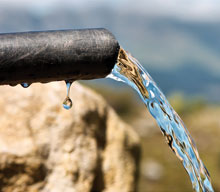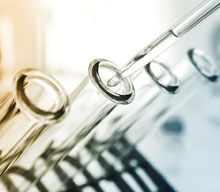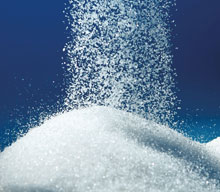Natural Clean Water Initiative
Rubicon is the answer to the World’s Water Purification Problems containing no chlorine, bromide, iodine, ferric chloride etc - environmentally friendly and safe, free from forming any DBP’s (disinfectant-by-products)
By Prideco Holdings Japan Director and Chief Technologist Pieter Du Toit
According to an assessment commissioned by the United Nations, 4,000 children die each day as a result of diseases caused by ingestion of filthy water. The report says four out of every 10 people in the world, particularly those in Africa and Asia, do not have clean water to drink.
From the WHO: Facts and figures on water quality and health.
The global health challenge: preventing water quality-related disease
No safe drinking-water: almost 1 billion people lack access to an improved supply
Diarrhoeal disease: more than 2 million annual deaths attributable to unsafe water, sanitation and hygiene Cholera: more than 50 countries still report cholera to WHO
The Health Opportunities: Implementing good practice
4% of the global disease burden could be prevented by improving water supply, sanitation, and hygiene
A growing evidence base on how to target water quality improvements to maximize health benefits
The World Health Organization says that every year more than 3.4 million people die as a result of water related diseases, making it the leading cause of disease and death around the world. Most of the victims are young children, the vast majority of whom die of illnesses caused by organisms that thrive in water sources contaminated by raw sewage.
A report published recently in The Lancet concluded that:
- 700,000 child deaths occurred from diarrhoeal disease alone in 2011
- 748 million people globally are still without access to safe drinking water
- 2·5 billion people lack access to basic sanitation
- 1 billion people practice open defecation, with nine in ten living in rural areas
- 165 million children worldwide with stunted growth risk compromised cognitive development, physical capabilities, and future school performance; resulting in a less productive generation, with unfulfilled potential to contribute to the workforce and the economy
Access to safe water and sanitation is essential to all development outcomes across the life course. It ensures healthy growth and prevention of water-borne and food-borne diseases causing diarrhoeal, which contributes to stunting in children. Contaminated and stagnant water also contribute to the global burden of trachoma, and vector-borne diseases. In other words, poor water sanitation and a lack of safe drinking water take a greater human toll than war, terrorism and weapons of mass destruction combined.
Chlorination Risks and Issues
A series of reputable peer-reviewed studies have shown links between water chlorination and increased cancer rates and found the use of chlorine, while effective in water disinfection, to be at best disputed and at worst problematical in terms of its longer-term potential health impacts.
A joint study undertaken in Japan by research scientists at the National Institute of Health Sciences and Shizuoka Prefectural University determined that natural organic substances originating from foods, including fruits, soy, and green or black tea, react negatively when tap water is chlorinated, forming dangerous cancer causing compounds. These deadly compounds have been named MX, which stands for "unknown mutagen", and are similar to the already well known and more easily detected cancer-causing THMs (Trihalomethanes).
According to a University of Florida report, exposure to THMs (Trihalomethanes) may pose an increased risk of cancer. According to Rebekah Grossman, THMs, chloroform and dibromochloromethane, are carcinogens; and another THM, bromodichloromethane, has been identified as a mutagen, which alters DNA. Mutagens are considered to affect the genetics of future generations in addition to being carcinogenic. A California study indicates that THMs may be responsible for reproductive problems and miscarriage. The study found a miscarriage rate of 15.7 percent for women who drank five or more glasses of cold water containing more than 0.075 mg/l TTHM (Total Trihalomethanes), compared to a miscarriage rate of 9.5 percent for women with low TTHM exposure. In addition to these risks, TTHMs are linked to bladder cancer, heart, lungs, kidney, liver, and central nervous system damage.
The Japanese scientists specifically mentioned that their studies showed that MX is created by the reaction of chlorine with natural organic plant phytochemicals such as catechin, which are contained in tea, and with flavonoids, which are found in fruits. In 1997, earlier studies by scientists in Finland determined that MX was 170 times more deadly than other known toxic by-products of chlorine, and their laboratory studies showed damage to the thyroid gland, as well as cancerous tumors.
THMs are created by the reaction of chlorine with humic and fulvic acids, which are the final breakdown products of vegetation, including decayed leaves and organic matter. Humic substances are the same as soil humus, of which the fulvic fraction is water soluble and readily transported into streams and waterways, as well as utilized nutritionally by plants.
Very recent scientific discoveries have identified and clarified the composition of fulvic and humic acids as containing a significant amount of nutritional phytochemical groups including hormones, sterols, fatty acids, polyphenols, and ketones, which subgroups include but are not limited to: flavins, flavonoids, flavones, tannins, catechins, quinones, isoflavones, tocopherols, etc.
These compounds are some of the most valuable and promising anti-cancer nutrients found in our foods and health supplements. Coenzyme Q10 is a quinone, vitamin B-2 is a flavin, vitamin E is a tocopherol, and citrus bioflavonoids including hesperidin, quercetin, and rutin are all flavonoids, green tea contains catechins, phenols, tannins, and isoflavones. Potentially all of these substances, and many more, are drawn in by chlorination.
Chlorine is also responsible for damaging the body's immune and hormonal systems by mutating the food-based plant estrogens and phytochemicals that support those systems. A healthy immune system should be the first and best line of defense against waterborne disease. It has been discovered that these phytochemicals remain intact, concentrated, and intricately combined within humic substances; which are valuable remnants of nature’s protective substances contained within fruits, flowers, pollen, nuts and seeds, as well as vegetative parts including roots, stems, bark, and leaves. Even the plant nucleic acids, RNA and DNA remain intact.
The fresh plant foods we eat react with the chlorinated tap water we drink with our meals, creating toxins. This means that fresh fruits and vegetables, green salads, green tea, black tea, herb teas, soy products, vitamin pills and various health supplements, and various pharmaceutical drugs, all can be implicated in a harmful combination with chlorinated water (and other chlorinated liquids with sucralose).
The poisonous cancer causing agents which are the result of this chemical combination are extremely toxic in infinitesimal amounts, so small and obscure that they are extremely difficult to detect. Very little chlorine is required to become harmful to human health. When the concentrations of phytochemicals are high, as in fruits and vegetables grown in very fertile soils, the harmful combination with chlorination intensifies.
It has been known for many years by the water treatment and chemical industries that chlorine reacts negatively with natural organic compounds. These industries call these compounds DBPs (disinfection by-products), which are known to cause cancer in populations whose drinking water contains them. THM, the most commonly known DBP, is known to cause a high incidence of bladder cancer and also shown to cause spontaneous abortion of fetuses. And, studies in Norway confirm this fact.
The U.S Environmental Protection Agency (EPA) has continually tightened their restrictions on THM's in public drinking water, and even tighter restrictions more than likely lie ahead. Yet it appears that many government agencies and chlorine-related industries have neglected to take a serious look at the long-term effects chlorination has on natural foods, health supplements, pharmaceutical drugs, in combination with the use of chlorinated tap water.
There is good reason for the public to seriously examine and question this entire issue. Many years ago laws were passed making chlorination of water mandatory. If drastic changes are made, the legal liabilities could be staggering. Certainly government or industry personnel have theorized about these problems.
Another area of concern relates to pharmaceutical drug safety studies performed on animals in the laboratory. Proper laboratory procedures require that studies be performed using highly purified drinking water or distilled water for lab animals. Clinical studies do not use chlorinated tap water. Yet, chlorinated tap water is a common denominator within the human environment.
Although chlorine has helped eliminate the risks of waterborne diseases such as typhoid fever, cholera and dysentery, there are many pathogens that are not controlled by chlorine. Other and better methods of water treatment do exist. The world, and ever-tightening EPA regulations are forcing the American water supply industry to consider alternative methods for disinfecting the public water supply. For years, environmentalists and engineers have battled the water treatment industry and large chemical companies in an effort to ban the use of chlorine in public drinking water.
The question remains what about people in populous areas, typically in SEA that certainly do not have the luxury of treated water by alternative processes such as Ozonation (also having side effects) UV (lacking precision) or RO which is just not affordable etc.
Conclusion
Rubicon water disinfectant addresses the water disinfection conundrum at a safe level of which all claims have been scientifically substantiated by the most reputable research institutions and endorsed by:
- The Department of Health, Republic of South Africa
- The Department of Health Services, Kerlanda State, Regional Analytical Lab, India
- Tshwane University of Technology
- CSIR – South Africa
- CSIR – GHANA
- USA- NGO-Blood: Water Mission: Africa Partnership
- Listed at the UN, UNICEF, UNIDO, UNRWA etc. and registered under various UNSPSC categories.























